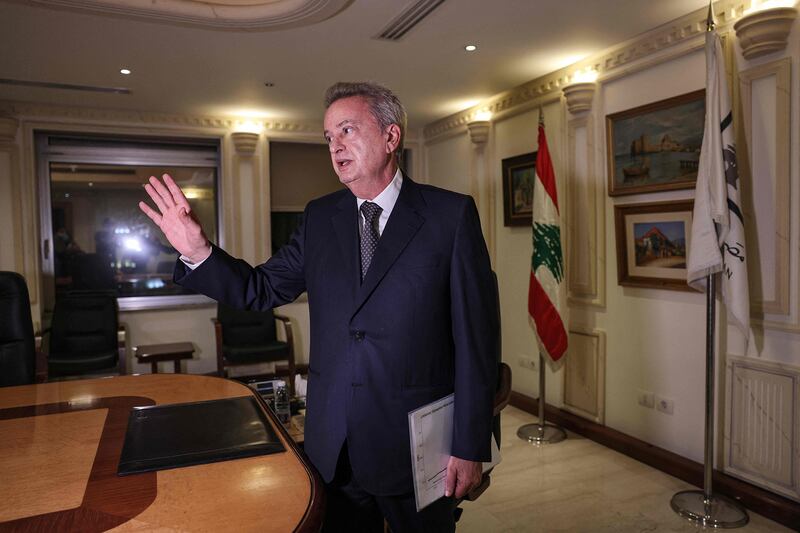At the end of this month, Lebanon’s central bank governor, Riad Salameh, is scheduled to leave office after 30 years, unless a shady political deal somehow extends his mandate until a replacement is found. Mr Salameh has been accused in several European countries of corruption, and France and Germany have issued Interpol “red notices” for his arrest.
However, there is a more profound message in the governor’s departure. In many regards, it represents the symbolic end of Harirism – the financial and economic strategy of the late prime minister Rafic Hariri to revive Lebanon at the end of its civil war in 1990. While Mr Hariri did rebuild Beirut’s historical downtown area, it was his monetary policy that really drove the Lebanese revival – until the country’s finances collapsed in 2019.
The basis of this policy was, very generally, to maintain parity between the Lebanese pound and the US dollar and attract capital to Lebanon through high interest rates on treasury bills and bank accounts. In this way, the state could roll over the debt indefinitely, relying on inflows to offset Lebanon’s perennial balance of trade deficit, so the balance of payments would more or less remain positive. When the inflows started declining at the beginning of the last decade, Lebanon’s financial situation became more precarious, which slowly undermined confidence in the system’s financial stability.
Yet Mr Salameh remained in office, even after the breakdown of 2019. He did so because the political class protected him, seeing him as a reliable keeper of their secrets and someone willing to do their bidding. However, when the governor himself became the target of multiple investigations in Europe and elsewhere, the politicians sensed that his time was up. Even though he continued to be protected, he also became, conveniently, a lightning rod for public anger, which deflected the anger from the politicians.
For many people, the end of Harirism came in 2022, when Saad Hariri, Rafic’s son, declared that he had withdrawn from politics. However, the real closing of the book will be Mr Salameh’s exit, precisely because the central bank governor is associated with the successes of Rafic Hariri’s years in office, whereas Saad, who was absent from politics in the 1990s at the inception and height of Harirism, never approximated those successes.

Mr Salameh was brought to the central bank in 1993 by Rafic Hariri after being his portfolio manager at Merrill Lynch. He was the principal architect, with the then prime minister, of the monetary policy adopted by Lebanon in the immediate post-war years. In those days, few people described the high interest rates offered on treasury bills as a Ponzi scheme, largely because Lebanon was thriving after years of conflict.
There was a serious glitch in 1998, when the government faced a fiscal crisis due to debt-servicing obligations, but this was resolved by issuing debt in foreign currencies. The banking sector expanded and Mr Salameh collected plaudits all around, including being named in the Euromoney Awards as best central banker worldwide in 2006. The optimism accompanying Rafic Hariri’s reconstruction programme washed off on Mr Salameh, and if anyone could claim to be the beating heart of Harirism, it was the governor.
It was also Mr Salameh who understood best that Lebanon’s financial system was built on an alliance between the sectarian political leaders or parties and a banking sector that had shrewdly integrated them into its affairs. The bankers bankrolled the politicians’ system of political and communal patronage, and in exchange the politicians protected the interests of the banking sector. At the heart of this nexus was one man, Mr Salameh.

Rafic Hariri, a dynamic man crucial for post-war revival, but also someone who could never be confused with a reformer, understood the game. Unless such a system was in place, he realised, his reconstruction ambitions would be held hostage by the political class. But he also had a political aim: Mr Hariri was always in need of building coalitions to advance his plans, and money was the best way to overcome political obstacles.
Perhaps most significantly then, Mr Salameh’s departure closes the book on a return to such a model. The political class has strangled the goose that laid the golden egg, and this probably spells the end of a prosperous Lebanese financial and economic system wrapped around its interests, as was the case until 2019. Certainly, the politicians will continue to plunder the state as best they can, but with Lebanon bankrupt and the politicians and bankers rejecting reform, the country will likely never regain what it had in the 1990s.
Harirism, though sometimes criticised by economists and others, was about Lebanon’s resurrection, albeit one based on very risky financial foundations. With Mr Salameh preparing to go home, the coda that he leaves behind is that Lebanon was living a self-destructive illusion, with the central bank governor as its impresario.
It’s remarkable that when he took office for the first time in 1992, Rafic Hariri seemed to represent a new type of Lebanese figure. He was not from a traditional political family, nor was he tied to a political party. His claim to fame was great wealth and he exemplified how a new business class was taking on a political role in the country. More than three decades later, Mr Salameh’s fate shows that this expectation was overblown, given the realities of the Lebanese state. The system both men helped create is clinically dead, as well it should be.






